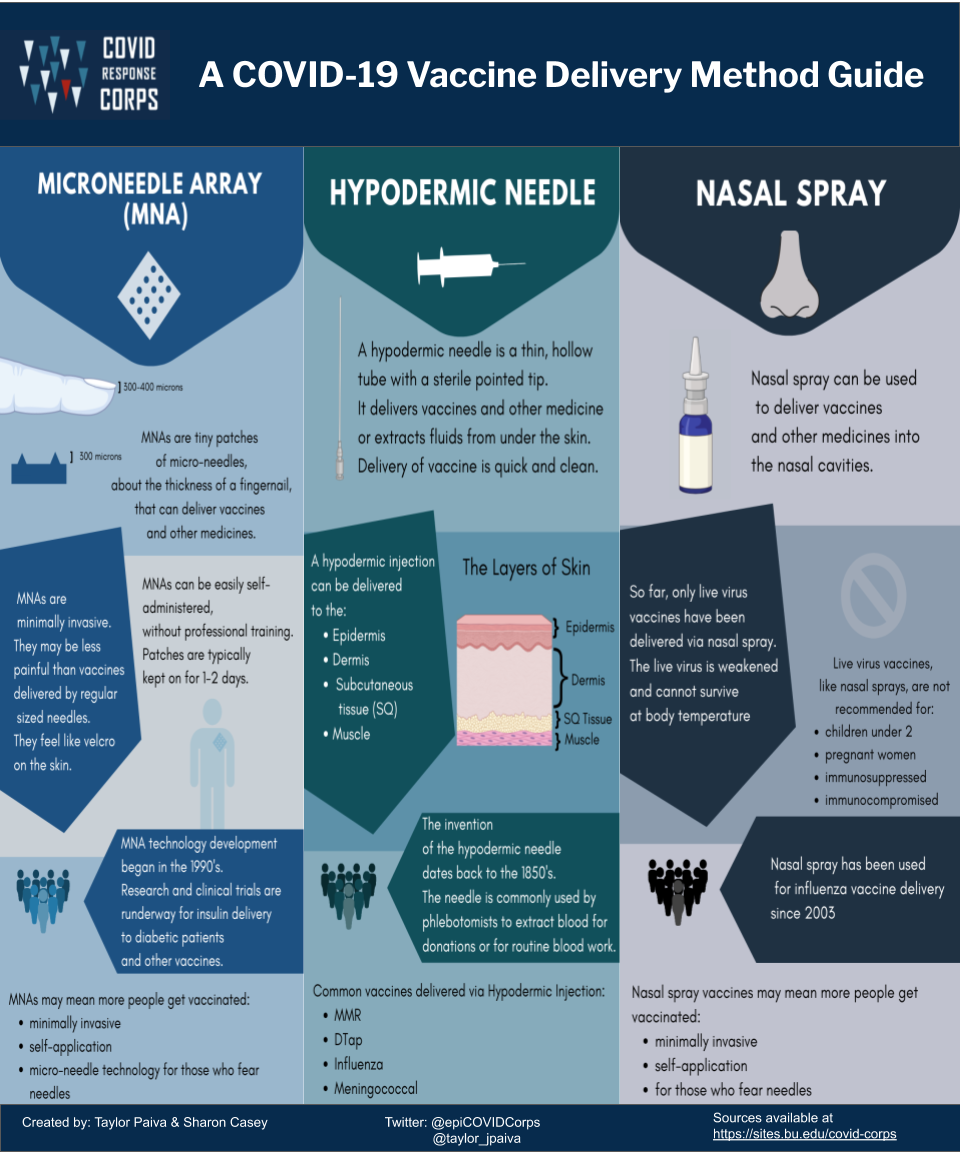Infographic Summarizing COVID-19 Vaccine Delivery Methods
Taylor Paiva & Sharon Casey
Mentor: Dr. Ellie Murray
Vaccines can be delivered to patients in a variety of ways. As many COVID-19 vaccines are under development, it is important to understand the various ways that the vaccine may be available to us. Currently, the COVID-19 vaccines in development can be administered in one of three different ways: nasal spray, hypodermic needle and microneedle array. Understanding these methods can help us make informed decisions about whether a vaccine is right for us and prepare us for when a vaccine becomes available. An overall infographic and sub-series of infographics for each administration type were created to help explain the delivery methods.
Download PDF Versions

View infographic details
A COVID-19 Vaccine Delivery Method Guide
MICRONEEDLE ARRAY
MNAs are tiny patches of micro-needles, about the thickness of a fingernail, that can deliver vaccines and other medicines.
MNAs can be easily self-administered, without professional training. Patches are typically kept on for 1-2 days. MNAs are minimally invasive. They may be less painful than vaccines delivered by regular sized needles. They feel like Velcro on the skin.
MNA technology development began in the 1990’s. Research and clinical trials are underway for insulin delivery to diabetic patients and other vaccines.
MNAs may mean more people get vaccinated:
- minimally invasive
- self-application
- micro-needle technology for those who fear needles
HYPODERMIC NEEDLE
A hypodermic needle is a thin, hollow tube with a sterile pointed tip. It delivers vaccines and other medicine or extracts fluids from under the skin. Delivery of vaccine is quick and clean.
A hypodermic injection can be delivered to the:
- Epidermis
- Dermis
- Subcutaneous tissue (SQ)
- Muscle
The invention of the hypodermic needle dates back to the 1850’s.
Common vaccines delivered via Hypodermic Injection:
- MMR
- DTap
- Influenza
- Meningococcal
NASAL SPRAY
Nasal spray can be used to deliver vaccines and other medicines into the nasal cavities.
So far, only live virus vaccines have been delivered via nasal spray. The live virus is weakened and cannot survive at body temperature.
Live virus vaccines, like nasal sprays, are not recommended for:
- children under 2
- pregnant women
- immunosuppressed
- immunocompromised
Nasal spray has been used for influenza vaccine delivery since 2003.
Nasal spray vaccines may mean more people get vaccinated:
- minimally invasive
- self-application
- for those who fear needles
Created by: Taylor Paiva
Infographic References:
https://www.ncbi.nlm.nih.gov/pmc/articles/PMC5287301/
https://www.ncbi.nlm.nih.gov/pmc/articles/PMC5492011/
https://www.ncbi.nlm.nih.gov/pmc/articles/PMC4119955/
https://www.ncbi.nlm.nih.gov/pmc/articles/PMC3419303/
https://www.cdc.gov/flu/prevent/nasalspray.htm
https://www.flumistquadrivalent.com
https://pubmed.ncbi.nlm.nih.gov/24512188/
https://www.npr.org/sections/health-shots/2020/08/28/906797539/what-a-nasal-spray-vaccine-against-covid-19-might-do-even-better-than-a-shot
https://www.cdc.gov/flu/prevent/nasalspray.htm
